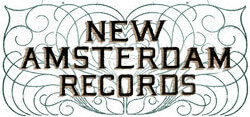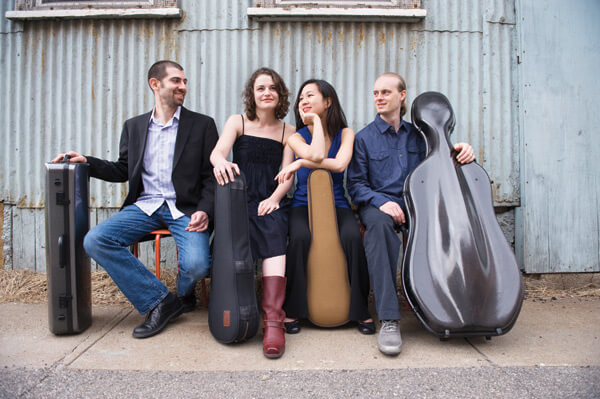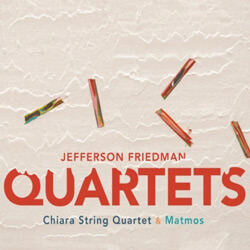 Every so often an album comes out with the right combination of substance and edge that you know represents something new, arising, and here to stay. That perfect mix of experimentation and popular appeal has created watershed albums like Wu-Tang Clan’s Enter the 36 Chambers, Nirvana’s Nevermind, or M.I.A.’s Arular. It’s been tough to find much in the way of contemporary classical music that possesses this substantive quality. The plethora of new material, the post-modern lack of meaning, and the predilection for technique or innovation for its own sake over musicality have made it difficult for the coherently new to emerge. In this way, New Amsterdam Records’ release of the Chiara Quartet‘s recording of Jefferson Friedman’s Second and Third String Quartets stands as a breath of fresh air.
Every so often an album comes out with the right combination of substance and edge that you know represents something new, arising, and here to stay. That perfect mix of experimentation and popular appeal has created watershed albums like Wu-Tang Clan’s Enter the 36 Chambers, Nirvana’s Nevermind, or M.I.A.’s Arular. It’s been tough to find much in the way of contemporary classical music that possesses this substantive quality. The plethora of new material, the post-modern lack of meaning, and the predilection for technique or innovation for its own sake over musicality have made it difficult for the coherently new to emerge. In this way, New Amsterdam Records’ release of the Chiara Quartet‘s recording of Jefferson Friedman’s Second and Third String Quartets stands as a breath of fresh air.

Jefferson Friedman – Photo Liz Linder (please forgive the cropping)
Friedman’s String Quartets capture your attention right away with their in-your-face intensity, but also reel you in closer with intriguing sonorities and drawn-out melodic wanderings. There is a spatial quality to the music, with different elements coming to the foreground at times and then receding to the background, or a sense of motion in the music’s drive and trajectory.
The rhythmic drive to the music is achieved through often constant nervous flutterings, detailed attention to accent patterns and articulations, and arriving at jagged grooves—the bows are really put to work. At its faster moments, the quartets are built from what could perhaps be best described as riffs. It’s this sense of the vernacular in the present day that gives Friedman’s music a real substance and potentially broader appeal. To make a historical analogy, in Mozart’s time sentence and period phrase structures were all over popular European music. Friedman manages to capture the feel and language of contemporary rock in the riffs and rhythms he creates, yet without departing or degrading the artistic quality implicit in a string quartet. It’s definitely art music, but someone who grew up on punk, metal, rap, or indie-rock could appreciate it without departing from their musical sensibilities. At the same time, the grooves often possess something of an Eastern European tinge along with the motoric drive of Prokofiev or Shostakovich.
While the percussive effects of the string quartet are part of this rhythmic drive, including heavy accent, plucking and even some strumming, there is rhythmic motion even in the short melodic gestures. This is brought to life well by the Chiara Quartet, in whose hands a note never just sits there, but always moves.
Friedman’s String Quartets go from this rhythmic intensity to sections of searching sonorities, frequently starting as close dissonances and often going to the upper reaches of the violins. The melodies possess a somewhat inchoate character, and the additive techniques used to build melody from small gestures into sweeping lines contributes to the searching quality. There’s a delicate beauty and inventive quality in these moments that paints pictures and draws the best expressive qualities out of Chiara Quartet. A memorable moment is in the Third Quartet’s second movement when sound clouds give way to a single note in the violin’s upper stratosphere at the softest dynamic possible that sounds like a delicate gust of wind high above the earth. There is an emotional depth in the music that is a refreshing break from the sense of detachment so prevalent in many contemporary compositions.

Chiara Quartet – Photo Liz Linder
Structurally, Freidman’s Quartets come off as clear and organic. The music moves through different moods and textures with clarity between sections, but without any of the nowadays formulaic minimalist approach. Ideas are clearly presented and developed, often with new material arising from what came before. There are not too many ideas to overload you, but enough to never get bored. Motives are often blurred by their rhythmic or harmonic surroundings and then brought into focus, only to recede again. The structure of the Third Quartet is particularly impressive for its sense of narrative and dramatic effect – the movements are labeled introduction, act, and epilogue/lullaby.
 While there are plenty of professional string quartets with the technical facility to record these pieces, the Chiara Quartet brings a rawness and priority on expression that is too often lost in the studio. They never sound too perfect or pristine despite their technical mastery. They truly dig right into the rhythmic intensity, and then let the sonorities breath when it’s time to. One can hear a rigorous approach to interpretation in their playing – Chiara Quartet truly owns these pieces, and they’ve clearly figured out the best ways to bring them to life. This is in contrast to many performances and recordings of new music in which the players just don’t sound emotionally invested enough in the compositions.
While there are plenty of professional string quartets with the technical facility to record these pieces, the Chiara Quartet brings a rawness and priority on expression that is too often lost in the studio. They never sound too perfect or pristine despite their technical mastery. They truly dig right into the rhythmic intensity, and then let the sonorities breath when it’s time to. One can hear a rigorous approach to interpretation in their playing – Chiara Quartet truly owns these pieces, and they’ve clearly figured out the best ways to bring them to life. This is in contrast to many performances and recordings of new music in which the players just don’t sound emotionally invested enough in the compositions.
My only criticism of the CD is the inclusion of electronic remixes by Matmos of both Quartets. The remixes are actually well done, with motives taken from the Quartets and subjected to transformation in order to create something new. But next to the Quartets themselves, they just don’t have anything near the quality or depth of Friedman’s compositions or Chiara Quartet’s playing. The actual compositions just possess so much more in terms of sound imagination that the electronic versions just can’t compete with. The Matmos remixes would be fine on a separate disc, but put together with the compositions cheapens the art form a bit.
What’s most exciting about this CD is the void it fills in contemporary classical music. There has been far too little emerging with coherence, substance, and broader appeal. Friedman’s String Quartets break new ground in molding together a musical language that rests on centuries of tradition, the latest developments in string playing and compositional techniques, and the influence of current popular music genres. With the drive and depth of interpretation of Chiara Quartet, the music sounds hard-edged and impossible to ignore.
—
David Pearson is a saxophonist residing in NYC.



















